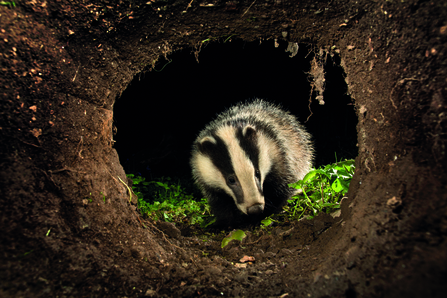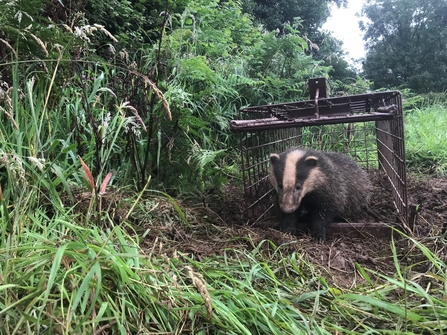10 minute read
Or, you can listen to the full conversation on The Wild Cornwall Podcast.
Two badgers. Image by Paul Browning Photography
10 minute read
Or, you can listen to the full conversation on The Wild Cornwall Podcast.
Well, they're just a very charismatic animal. We see them very rarely in our environment these days. You might catch a glimpse of one in a hedgerow or on a night-time film, but because they’re nocturnal we don't often see them. When we get that chance to see them in the wild for our vaccination project and get close to the animal, it's really exciting. They are a fantastic animal.
Badgers are omnivores, so they eat pretty much anything they can get hold of. For example, mushrooms and – this time of year – blackberries. You'll see badger latrines, full of their scat or their dung. They’re called dung pits because they dig a pit and actually defecate in that pit! This time of year they're basically a bright purple colouration with lots of seeds…
But their main food is earthworms! They love digging, and just dig down and get that fantastic source of protein.
Their teeth are for other things in their diet. They take nuts, for example, and so having really strong teeth allows them to get through anything in their environment that might be of interest. They are also territorial animals: they have their territories and having teeth allows them to defend themselves from other badgers in in other territories.
Well, this is obviously a bit of speculation… but people believe that you see this in quite a lot of mustelid animals where they have a kind of mask. That contrast between the bright white hair and the jet black hair gives them that mask effect. So it looks quite scary… the way the lines go down the face towards the mouth sort of says ‘I do bite! Don't come near!’

Badger, Image by David Chapman
They create these amazing labyrinths on the ground and they dig big holes which have a D-shaped entrance. That's how you tell the difference between that and a rabbit or a fox hole. It’s like that because they have a very flat profile. Each hole can go down a couple of meters and some of them are three storeys deep… and some of the bigger setts around our countryside are absolutely massive structures!
And then that can accumulate into their multiple hole setts. There are actually four different classifications of sett. You've got the main sett, which is their main home. This is the maternity sett where they have their young. You then have a subsidiary sett, which is usually a similar size to a main set, but often off in the distance. It can sometimes be used by a new part of that population. Between that and main sett (sometimes adjacent to the main sett) is an annex sett. It's called an annex because the population can change and when there is a bigger litter the annex can be occupied or abandoned over time. Finally, there’s the outlier sett, which you often get in hedges around Cornwall. These outlying setts might have one or two holes, which are usually the extent of their territory. Badgers use these when they're going off on exploratory journeys across their territory. They'll go in and have a night stop in their little B&B in their outlier sett… and then they'll go back to their main sett to see the rest of the clan after they've been out exploring.
Well, there has been a lot of culling in the Southwest, so the numbers are inevitably in decline. Badgers are also up against it with car traffic: lots are killed because of that each year. The population is generally high in the Southwest, but, as a result of culling, I expect their population has reduced. We're very lucky on our nature reserves, where we've still got a few really big healthy setts; it's lovely to go out and see the badges there.
Being involved in the vaccination project you can forget how lucky you are to see badgers. We need to trap them in order to carry out the inoculation. It’s a really privileged experience.
We believe that vaccination is a long-term strategy to deal with the tuberculosis issue that is in cattle and other wildlife. It’s not just badgers that have tuberculosis in their lifecycle: deers, foxes, and almost all mammals can carry it, as do humans. So we want to vaccinate – just as we’ve done with the human population – instead of cull, and keep badgers in our environment. They’re really valuable creatures: they create habitats for other animals, control some of the insect populations, and they create corridors for other animals to use.
Vaccination is the long-term strategy: it will keep the hierarchy of the sett healthy over time. We do it over a four year cycle, which allows you to vaccinate all badgers of that sett because they can last up to four to five years in the wild. Any sick badgers that may already have TB will naturally die out and we’ll keep that new population healthy, especially if we catch the cubs. The population within that sett will therefore be healthier in the long term.

Tom Shelley
Donate to badgers this Christmas
It’s a lot of work! But it's really exciting to do. We've got some fantastic volunteers helping, as well as members of staff. And we've got a really good partnership with the Zoological Society of London (ZSL). They are a very keen and active party that has the scientific background behind the project – we’re very lucky to have this partnership!
You have to go out and you find where the badgers are on land, whether on a nature reserve or on private farmland. You need to ensure badger populations living next to each other are vaccinated at the same time to keep the wider population healthy. You have to find out where the setts are so that you know where to put the traps.
The traps need to be fully cleaned, of course, so as not to spread disease. Then you put that trap in the ground near that sett, usually nearby near one of their pathways where they're running past… You then open that trap and leave a stone there. The stone needs to be heavy enough that only a badger could flip it over… and underneath that stone you place peanuts! They’re like catnip for badgers! They absolutely love peanuts.
They badgers will then find that bait… and then gradually over around a week to ten days you move that stone further and further back into the trap. This is why we need such a good team of vaccination volunteers and the farmers who have been helping us with this.
Once those badgers are taking the bait from the back of the trap, we know that they're confident to go into it. We can then trigger the trap. That’s done by tying some string and wire around the stone. There’s a little clasp that holds the trapdoor open at the front – which is completely harmless – and when the badger goes in and digs that stone, they move that string, the string pulls the clasp and then that trap comes down and closes.
Obviously no animal likes to be trapped, but we get out there early doors to get to them. And when I say early doors, I’m talking about setting your alarm for an hour before sunrise. In the height of summer, you’ve got a 3am alarm clock going off, and then you're off down the road. It’s first light – just light enough to see the badgers in their traps. You go out there, you do the inoculation and then let the badges out. They run out and go down the holes back into their setts. And the vaccination is carried out. The key thing is their welfare and we try not to keep them in the traps too long.
You get very good at having a siesta in the middle of the day! You become a bit more nocturnal… just like the badgers! A lot of hard work goes into it: the tools required, digging the traps, carrying the traps, walking through the countryside. We’re very lucky to have four-wheeled drive vehicles – and particularly to have farmers who want to work with us on their land and a band of volunteers who happy to come out and help.
Yes, we set that up to vaccinate badgers on more of our nature reserves - and we’ve been doing it ever since! But it has also stimulated a lot of interest in vaccination within Cornwall. The Zoological Society of London (ZSL) were already doing this in West Penwith, and with ZSL, we talked with lots of farmers about TB.
That project got a lot of interest. We had a fantastic opportunity in mid-Cornwall with a collective group of farmers and Imerys, the clay company, to come together, working on a project. We're very lucky to have those farmers there, contributing financially to that project as well. We've been vaccinating together for four years in that big area there of thousands of acres.
It certainly has. We’ve certainly seen in the press in the last 18 months that Defra are certainly looking vaccination as the strategy rather than culling, reducing and removing culling from their TB eradication policy and using vaccination instead. Professor Rosie Woodroffe, the lead scientist on the ZSL work, has been talking with Defra for a long time about how to reduce the prevalence of TB in badgers and show vaccination to be the better long-term strategy.
The data we’ve been gathering from the project in mid-Cornwall, together with the work down in West Penwith, has contributed to enabling that change whereby the government is promoting vaccination now.
Absolutely. There are lots positive stories, but they’re only within certain areas across Cornwall – and there are lots of places where culling is taking place. But the culling hasn’t eradicated TB because there's still TB in cattle. Cattle to cattle transmission is a big part of the TB situation. So, we want to make sure that the badgers that are there are healthy.
And we also want to make sure that they're there in our environment because they're a native species, intrinsically part of that environment. They help other animals. They’re very charismatic. And in their own right they deserve to be there. So, the more money that we can generate, the better. It will mean we can carry on vaccinating in new areas where Defra funding might not be available. It’ll gives us that opportunity to vaccinate more badgers, to have that long term strategy which will take badgers out of the TB equation and keep badgers healthy and thriving in our environment.
Well, donating to our upcoming Christmas Badger Vaccination Appeal will help loads, so that we can buy more tools and support more work going on across Cornwall. Also volunteering… a lot of people’s time is involved in vaccination, so if we can get more people helping out that always helps.